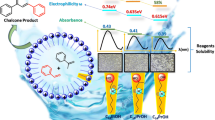Abstract.
The bis phenoxide forms of (1,2)bis(2-hydroxybenzamido)ethane(I), (1,5)bis(2-hydroxybenzamido)3-azapentane(II), (1,3)bis(2-hydroxybenzamido)propane(III), and (1,8)bis(2-hydroxybenzamido)3,6-diazaoctane(IV) undergo facile hydrolysis of one of the amide groups (0.02 ≤ [OH − ]T (mol dm − 3) ≤ 0.5, 10% MeOH (v/v) + H2O medium) without exhibiting [OH − ] dependence. The reactivity trend follows I ~ II > > III ~ IV with low activation enthalpy {25.7 ± 2.8 ≤ ΔH≠ (kJ mol − 1) ≤ 64.8 ± 7.0}. The high negative and comparable values of activation entropy {− 234 ± 8 ≤ ΔS≠ (J K − 1 mol − 1) ≤ −127 ± 20} are consistent with closely similar, and ordered transition states which can be assembled by favourably oriented phenoxide groups. The solvent kinetic isotope effect for I, k H2O/k D2O + H2O ~1 (20 and 50 volume% D2O), indicates that proton transfer is not involved as a part of the rate controlling process. The observed slowing down of the rate of this reaction for I in the micellar pseudo phase of CTABr also supports the proposed mechanism. Under pre-micellar conditions, however, rate acceleration is observed, a consequence believed to be associated with the capping effect of the hydrophobic tail of the surfactant cation forming the reactive ion-pair, CTA + , (I-2H)2 − exclusively in the aqueous pseudo phase.

The bis phenoxide species of (1,2)bis(2-hydroxybenzamido)ethane, (1,5)bis(2-hydroxybenzamido)3-azapentane,(1,3)bis(2-hydroxybenzamido)propane, and (1,8)bis(2-hydroxybenzamido)3,6-diazaoctane undergo intra molecular general base catalysed hydrolysis. Kinetic evidence indicates ion-pair catalysis in the presence of the cationic surfactant, CTABr.
Similar content being viewed by others
References
Brown R S, Bennet A J and Slebocka-Tilk H 1992 Acc. Chem. Res. 25 481
Bowden K, Hiscocks S P and Reddy M K 1997 J. Chem. Soc. Perkin Trans. 2 1133
Sunatsuki Y, Nakamura M, Matsumoto N and Kai F 1997 Bull. Chem. Soc. Jpn. 70 1851
Stassinopoulos A, Schulte G, Papaefthymiou G C and Caradonna J P 1991 J. Am. Chem. Soc. 113 8686
Stassinopoulos A and Caradonna J P 1990 J. Am. Chem. Soc. 112 7071
Nguyen C, Guarjardo R J and Mascharak P K 1996 Inorg. Chem. 35 6273
Nayak S, Dash A C and Lahiri G K 2008 Transit. Met. Chem. 33 39 and references cited therein
Ahmad R, Khan M N and Khan A A 1976 Ind. J. Chem. 14A 807
Dash A C and Mishra A N 1998 Ind. J. Chem. 37A 961
Nayak S and Dash A C 2003 Ind. J. Chem. 42A 2427
Dash A C and Rath R K 2004 Ind. J. Chem. 43A 310
Chandra S K and Chakravorty A 1992 Inorg. Chem. 31 760
Frost A A and Pearson R G 1961 Kinetics and mechanism, 2nd edn (New York: Wiley) p 49
Nayak S, Dash A C, Nayak P K and Das D 2005 Transit. Met. Chem. 30 917
Nayak S and Dash A C 2006 Transit. Met. Chem. 31 813
Slebocka-Tilk H, Bennet A J, Keillor J W, Brown R S, Guthrie J P and Jodhan A J 1990 J. Am. Chem. Soc. 112 8507; (b) Slebocka-Tilk H., Bennet A J, Hogg A J and Brown R S 1991 J. Am. Chem. Soc. 113 1288
Galabov B, Cheshmedzhieva D, Ilieva S and Hadjieva B 2004 J. Phys. Chem. A108 1147
Khan N and Azri H R 2010 J. Phys. Chem. B 114 8089
Al-Lohedan H, Bunton C A and Mhala M M 1982 J. Am. Chem. Soc. 104 6654; (b) Dash A C, Dash B ad Panda D 1985 J. Org. Chem. 50 2905
For Y = \((k_{\rm W}^{\prime} -k_{\rm obs})^{-1}\), \(\sigma (Y) = \sigma (k_{\rm obs}) \times (k_{\rm W}^{\prime} -k_{\rm obs})^{-2}\), and w(Y) = [σ(Y)] − 2
Menger F M, Yoshinaga H, Venkatasubban K S and Das A R 1981 J. Org. Chem. 46 415
Fuoss R 1958 J. Am. Chem. Soc. 80 5059; Eigen M 1954 Z. Physik. Chem. (Frankfurt) 1 176
Dash A C and Patnaik A K 1995 J. Chem. Res. (S) 230 (M) 1529
Author information
Authors and Affiliations
Corresponding author
Electronic Supplementary Material
Below is the link to the electronic supplementary material.
Rights and permissions
About this article
Cite this article
DASH, S.C., DASH, A.C. Proximity effect on the general base catalysed hydrolysis of amide linkage: The role of cationic surfactant, CTABr. J Chem Sci 123, 497–507 (2011). https://doi.org/10.1007/s12039-011-0084-5
Received:
Accepted:
Published:
Issue Date:
DOI: https://doi.org/10.1007/s12039-011-0084-5




